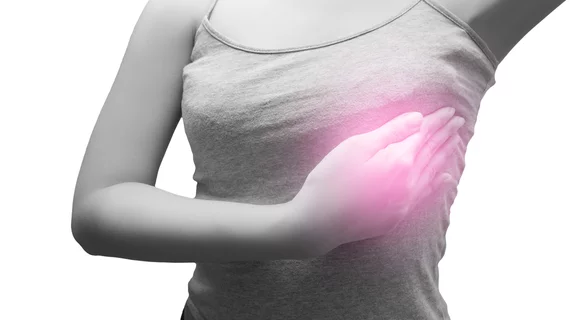Diagnostic imaging serves no purpose in assessing breast pain, internal medicine docs stress
Diagnostic imaging, and particularly MRI, serves no purpose in assessing patients’ breast pain, and physicians should largely discontinue the practice.
That’s according to a group of three internists with the University of Texas Southwestern Medical Center, in Dallas. Writing Monday in JAMA Internal Medicine, the group highlighted the case of a 36-year-old woman who presented with three months of discomfort and no personal or family history of cancer.
Primary care ended up ordering a diagnostic mammogram and later breast MRI that produced little to no benefit to the patient.
“Despite concerns from patients and clinicians that pain may be due to occult cancer, breast pain with normal history and normal examination results is not a risk factor for cancer, especially in young women with nonfocal pain,” Colin Bergstrom, MD, and colleagues wrote Aug. 17. “Diagnostic imaging should not be pursued, and patients should be reassured and provided with treatment strategies to alleviate symptoms.”
Instead of imaging, physicians should consider providing reassurance or treatment options. Advice on bra-fitting can sometimes help, they noted, and if the pain persists, anti-inflammatory drugs, caffeine avoidance and estrogen-receptor modulation are solid options.
Such chest pain is a common problem, accounting for upward of 70% of breast-related complaints in primary care, the authors noted. Several studies, however, have already proven the lack of value in imaging for these scenarios. In one analysis across three community hospitals, almost 800 women presented with breast pain over a one-year period and underwent imaging, with zero cancers or high-risk legions discovered near the pain source.
Even worse, that initial mammogram can result in a “cascade” of subsequent unnecessary testing, as was the case for the aforementioned patient.
“Optimal imaging strategies for women with focal pain are less clear, though breast magnetic resonance imaging is not warranted in the evaluation of breast pain,” Bergstrom and colleagues advised. “Because age is an important risk factor for breast cancer, in women older than 40 years with more focal pain imaging with ultrasonography and or mammography may be considered, though breast pain even in older women rarely is indicative of underlying cancer.”
Read more of their “Teachable Moment” opinion piece in JAMA here.

